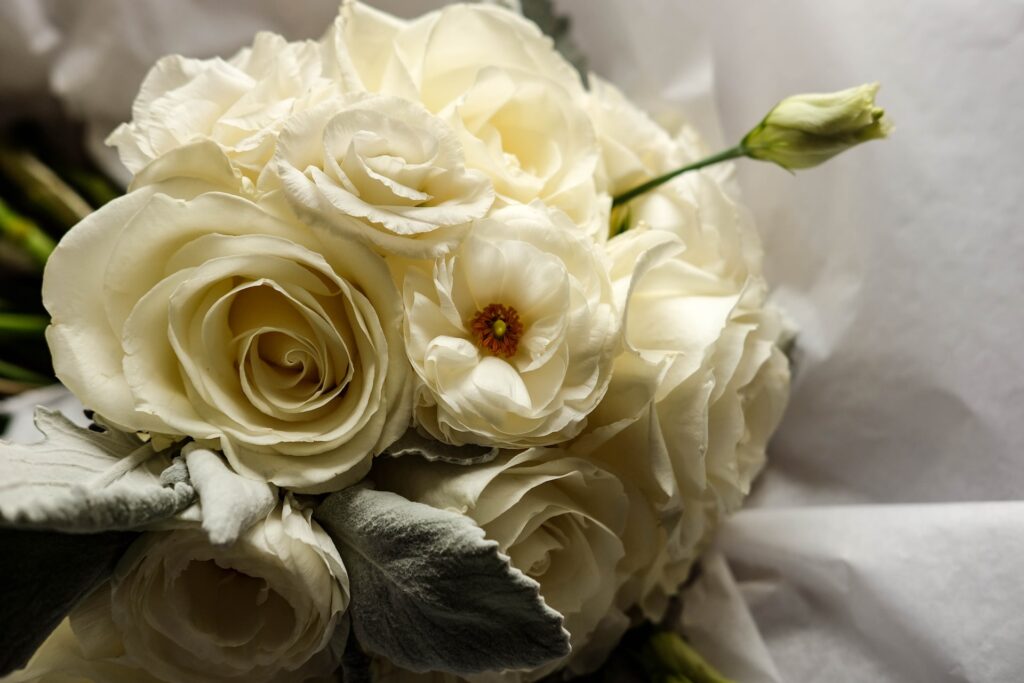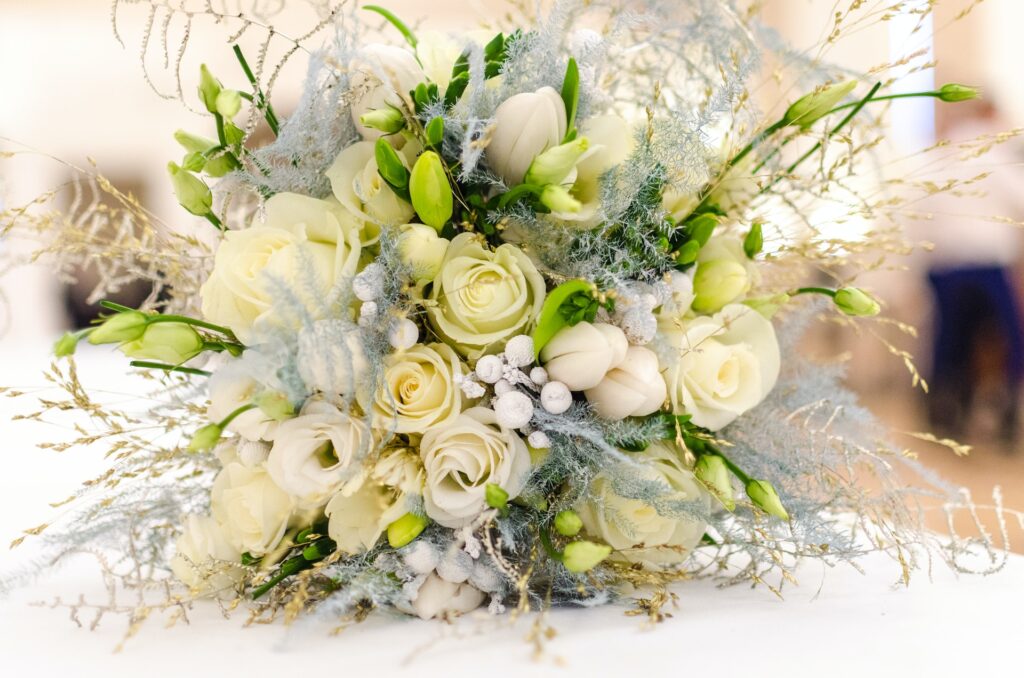
Monochromatic, all-white weddings can range from rustic to luxurious depending on the decorations and accents. And flowers are included in that list. While using one color can look clean and elegant, it can also look flat and boring, too. So it’s important to carefully choose the right blends of textures, sizes, and flower types so that your wedding bouquet sings. In this post, we’ll explore seven ways to spice up your all-white bouquet, so it’s the breathtaking focal point of your wedding dreams.
Whether you’re describing your dream florals to your vendor or creating your own DIY arrangement, it’s important to know what you like—and what issues you can run into with an all-white bouquet. Monochromatic arrangements certainly aren’t boring! In fact, they can be elegant and breathtaking. But they can also feel limiting. So these seven tips are simple ways to make your bouquet beautiful, according to your personal taste.
1. Add Textures

With an all-white bouquet, you can’t play around with color. But you can certainly experiment with texture! Texture will make your bouquet interesting while giving it depth and volume, too. After choosing your main flower(s), add accents with plenty of texture. For example, silver dusty miller will add textured and color depth to any white arrangement. Or you can use textured brunia berries, which will also add a shape element.
2. Include Baby’s Breath
While baby’s breath is still a flower, it’s a tiny one! And its tiny size is exactly why it’s a perfect addition to a bouquet. For starters, all those little flowers have a different texture than your typical flower—and they’re smaller than most, too. This will make your all-white bouquet visually interesting. What’s more, each flower has a stem, of course! All those stems with all those little flowers adds volume to your arrangement, too.
3. Mix and Match Flowers
Not all white flowers are the same shade of white. Some are a snow white, while others are eggshell or off-white. By mixing and matching different white flowers, you get a bouquet that’s a bunch of different colors—without actually being different colors. It adds dimension to your bouquet, and it keeps it interesting, too. No more arrangements of three lilies tied together! (Unless, of course, that’s your thing.)
4. Make It Bigger

If your bouquet needs some more pizazz, try adding more flowers. A bouquet of a few brightly colored flowers has no problem standing out against a neutral dress. But an all-white bouquet can sometimes get lost against a white dress. So make sure your flowers take up their space! Add more baby’s breath and foliage to add volume. Or create a bouquet that’s long, so it trails down the front of your dress when you hold it.
5. Choose Your Wrap Carefully
Your bouquets should be wrapped for easy holding. But your wrap can make a big difference, especially on an all-white bouquet. If you want a splash of color, put it on your wrap! You can choose one of your non-white wedding colors, or something more romantic—like the color of the bride’s eyes. Or, for a more muted look, choose a neutral wrap, like burlap or silk.
6. Use Some Greenery
It can be challenging to create a truly all-white bouquet. That’s where greenery comes in! Greenery adds a nice, natural splash of color to your bouquet that actually enhances the white in it. Because green is so saturated, the white flowers really pop against it. And because most flowers have green in their stems already, it almost doesn’t feel like an extra color—it’s just an extension of the flowers.
7. Try Mostly White Flowers

If greenery is too bold for you, then consider flowers that are mostly white. For example, white button pom flowers have a little bit of yellow in their center. Similarly, white scabiosas have hints of green at their core, and white anemones are a purple-blue velvet in the middle. All of these flowers will add a touch of color and depth, without overwhelming with arrangement with color.
Conclusion
Because of their simplicity, monochromatic, all-white bouquets run the risk of being boring and flat. Thankfully, there are plenty of ways to brighten them up into stunning statement pieces. With the right textures, volume, and color (even if it’s just different whites!), your wedding florals can be the star of the show. Aside from the dress and the cake, of course!
Would you ever use all-white arrangements for an event? Why or why not?

